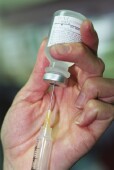- Skip Storing This Everyday Product in the Fridge Door
- Green Tea + B3 Pairing May Boost Brain Health
- Navigating Your Midlife Crisis: Embracing New Possibilities
- City Raccoons Showing Signs of Domestication
- Mapping the Exposome: Science Broadens Focus to Environmental Disease Triggers
- One Week Less on Social Media Linked to Better Mental Health
- Your Brain Changes in Stages as You Age, Study Finds
- Some Suicide Victims Show No Typical Warning Signs, Study Finds
- ByHeart Formula Faces Lawsuits After Babies Sickened With Botulism
- Switch to Vegan Diet Could Cut Your Greenhouse Gas Emissions in Half
Doctors ID New Ways to Get More Kids Vaccinated


Doctors are still struggling to find effective ways to convince wary parents of the importance of vaccinating their infant children.
The whooping cough epidemic of 2011-12 made no significant difference in Washington state parents getting their babies up to date on their shots, researchers found. Nearly one-third of their infants remained unprotected against whooping cough even as the virus spread across 49 states, according to one of three vaccination-related studies published online Aug. 18 in the journal Pediatrics.
About nine out of 10 parents in the United States keep up with the recommended childhood vaccination schedule, getting their child shots to protect against infectious diseases such as measles, mumps, whooping cough, polio and hepatitis B, according to the U.S. Centers for Disease Control and Prevention.
But doctors and public health officials have found convincing that final 10 percent of parents extremely challenging.
Parents’ response to the whooping cough outbreak is “somewhat humbling” for pediatricians who believe progress is being made regarding the childhood immunization rate, said Dr. Carrie Byington, chief of the American Academy of Pediatrics’ committee on infectious diseases.
The vaccination rate received only a slight bump during the whooping cough epidemic — up to 69.5 percent of infants in Washington state — and fell back to 67.6 percent afterward.
“It tells us we still have a ways to go in understanding human behavior and what motivates people regarding their health,” Byington said.
One way to predict which parents will reject vaccination for their children is to keep track of who refuses their baby a vitamin K shot at birth, Canadian researchers report in one of the Pediatrics studies.
Vitamin K is recommended for newborns to prevent a rare bleeding disorder that can result in long-term brain damage and death, researchers said in background information.
Only a small minority of parents in Alberta, Canada, refused a vitamin K shot for their newborns between 2006 and 2012, the study found.
But children whose parents declined vitamin K were 14.6 times less likely to be immunized with any recommended childhood vaccines by age 15 months, compared to kids who got vitamin K.
Byington said refusal of vitamin K at birth “is a factor that can help pediatricians identify vaccine-hesitant parents.”
But how to convince those parents of the importance of vaccination?
Indiana University researchers tested four messages in a national online survey involving more than 800 parents of children younger than 12 months old. “We wanted to get parents where we knew this would be an upcoming decision for them, where they were thinking about doing it but hadn’t done it yet,” said lead author Kristin Hendrix, an assistant professor of pediatrics at the Indiana University School of Medicine in Bloomington.
The messages, which advocated for the measles-mumps-rubella vaccination (MMR), included: a simple vaccine information statement from the CDC; the CDC statement plus information on the vaccine’s benefits to the child; the CDC statement and mention of societal benefits of vaccination; and the CDC statement plus information on the importance of vaccination for their child and society as a whole.
Messages that focused on the benefits to the child had the most impact, researchers found.
More than 90 percent of parents who heard the child-focused message or the combination child-society message said they intend to get their infant vaccinated, compared with 86 percent of parents who received just the basic CDC information.
“We found parents who received the information that really drove home the benefits directly to their child, that was the information that really resonated and resulted in the highest levels of intent to vaccinate,” said Hendrix.
The CDC has worked hard to create a less confusing immunization schedule for parents to follow, said Dr. Jennifer Frost, medical director of the Health of the Public and Science Division of the American Academy of Family Physicians.
Despite this, “I think hesitancy is increasing, and that’s a problem,” Frost said. “There’s a lot of information on the Web that parents look at and believe because it’s out there, and it can be very hard to counter.”
Vaccines are safe and effective, Frost added. “Parents who are hesitant — even though they think they are doing it for the benefit of their child — are actually putting their child at risk,” she said.
More information
For more information on U.S. vaccination rates, visit the Centers for Disease Control and Prevention.
Source: HealthDay
Copyright © 2025 HealthDay. All rights reserved.










